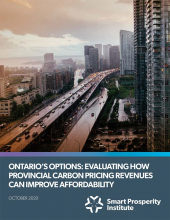October 8, 2020
A Smart Prosperity Institute report summarizes the benefit of a Made-In-Ontario carbon pricing system and offers to the province the freedom to decide how revenues should be returned to households. There are a range of options to offset the increases in carbon costs households will bear, including offering tax cuts or increasing tax credits. This balancing of climate action and affordability will become even more important in a post-COVID-19 Canada still striving for net-zero emissions.
Summary of Findings:
- The Ontario government can have a carbon pricing system and also work to reduce taxes to make life more affordable. The government has a range of options on how money can be returned to households, including cutting taxes and issuing rebates.
- This paper presents four options for using carbon price revenues. The distributional impacts of each option on the average household is measured by income quintile. This helps show how households with different income levels would benefit from each approach.
- Option 1: Increase the basic personal amount (income tax credit) by $6000 in 2020, $8000 in 2021 and $10,000 in 2022.
- Option 2: Reduce the HST by 0.9% in 2020, 1.1% in 2021 and 1.3% in 2022.
- Option 3: Develop a provincial version of the Climate Action Incentive.
- Option 4: Increase the Ontario Trillium Benefit by $350 in 2020, $450 in 2021 and $540 in 2022.
- Increasing the Trillium benefit would have the largest average benefit for low-income households.
- Low and middle-income earners (all households who earn under $93,157 annually) only receive a positive benefit from revenues from progressive rebate options.
- A $50/tonne revenue neutral carbon price would allow the province to lower the provincial component of the HST from 8% to 6.7% by 2023.
READ THE REPORT: Ontario’s Options: Evaluating How Provincial Carbon Pricing Revenues Can Improve Affordability
READ THE BLOG: A Made-In-Ontario carbon pricing system could support affordability for families




